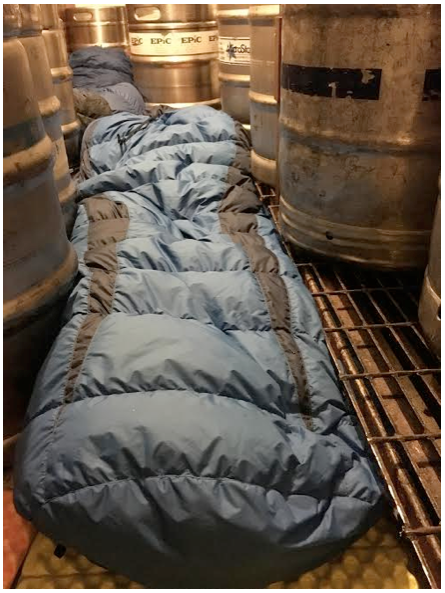
By Christina Heilman, PhD, ATC, CSCS
Although manufacturers use a theoretically sound standard to test the performance of sleeping bags, the testing standards are inconsistent (McCullough, 2009). Manufactures of sleeping bags adhere to the standard of EN 13537, which was created by the European Outdoor Group, companies around the world who make and supply camping, hiking, and mountaineering gear.
The EN 13537 standard states:
“For EN 13537 temperature tests, a full-size mannequin with heaters and temperature sensors is dressed in one layer of long underwear and a hat. It is placed inside the sleeping bag being tested. The bag is laid atop an insulating sleeping pad inside a climate-controlled chamber. The mannequin is heated to simulate body warmth and measurements are taken of the air in the climate chamber and the “skin” surface of the mannequin. From these measurements, the insulation value of the sleeping bag is calculated.”
There are five sleeping bag testing centers around the world that perform this test. The problem, according to Dr. McCullough who is one of the textile scientists at the Testing Centers of Sleeping Bags at Kansas State University, is that each lab’s mannequin differs and there is no standardization of the thermal properties of the long underwear, hat, socks and sleeping pads. Thus, the results may vary between testing centers. For example, Dr. McCullough reported that highly insulated sleeping bags could vary as much as 20 degrees (F).
Where does that leave the consumer?
At MTI we don’t have the equipment to test sleeping bags to the EN 13537 standard, but we are interested in better understanding sleeping bag performance. Some question include:
- What is the insulation effectiveness of sleeping bags?
- Is there a difference in sleeping bags with the same rating among different manufacturers?
- What is the difference in sleeping bags with different temperature ratings, from the same manufacturer?
Mini-Study Design
To compare sleeping bag ratings we started experimenting with two identical 15 degree F sleeping bags: Marmot Sawtooth and Marmot Pinnacle. Each bag was approximately 5 years old. One difference between the bags was the down-fill: Sawtooth = 650-fill and Pinnacle = 800-fill.
Other differences include weight and cost:
Sawtooth: $250, 3lbs, 1 oz.
Pinnacle: $320, 2lbs, 8 oz.
We placed two Nalgene water bottles filled with boiling water into the middle of each sleeping bag.
For two hours, sleeping bags rested on a Thermarest Z-Lite pad in a 37 degree F restaurant beer cooler.
We measured heat loss by taking the water temperature inside the water bottle with a VeeGee digital thermometer every 30-minutes for two hours.
Implications
As a preliminary finding, we found that the 800-fill bag lost more heat as compared to the 650-fill bag over two hours, 55.3 and 50.9 degrees F respectively.
The 800-fill bag lost 4.4 degrees more compared to the 650-fill bag over the two hour testing period. Stated in another way, for every 30-minutes the 800-fill lost one degree more than the 650-fill.
In addition, we had a control water bottle that was not insulated and sat on a Thermarest pad. Interestingly, the control water bottle had a 122.3 degree F loss of heat during the two-hour trial.
That’s over two times the amount of heat loss compared to the water in the sleeping bags.
Next Steps
This mini-study had a few issues. First, there was some variance in the rate of heat loss among the different Nalgene water bottles. Before we conducted the study, we tested the heat loss of each water bottle sitting in the cooler. The water bottle placed in the 800-fill bag lost 1.1 more degrees than 650-fill when sitting with no insulation in the cooler for two hours.
Is it possible that some heat loss from the 800-fill bag may be due to how the water bottle losses heat?
To better understand this question, we are wondering if the material in the water bottle isn’t consistent due to age and heat tolerance. We’re exploring if brand new Nalgene water bottles will be more consistent with heat loss or if there is a better vessel made with better material, such as aluminum.
Second, bags change over time. The fill-in down may lose it’s loft or get dirty, which can impact temperature ratings. We could wash the bags to remove dirt, but washing may reduce performance according to the EN 13537 standard. Therefore, the data is preliminary and difficult to imply any results.
The data does spark an interesting question, do you want lighter gear (800-fill) or stay warm in your sleeping bag (650-fill)? We will further develop the test design and continue testing sleeping bags.
Questions, Comments, Feedback? Email coach@mtntactical.com
Sources:
- https://outdoorindustry.org/pdf/EN13537Mccullough062209.pdf
- https://outdoorindustry.org/pdf/EN13537TestLabComparisonMethod.pdf
- http://sectionhiker.com/sleeping-bag-temperature-ratings-fact-or-fantasy/
You Might Also Like Rob’s Overnight Hunting Kit